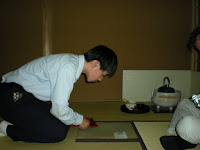




Eleven...or Ju Ichi...brought us to Hasaki Senior High. The big difference is that Senior High is non-compulsory. What does that mean? Well, in Japan, students must go to elementary school, which goes from grades 1-6, and junior high school, which is from grades 7-9. However, Senior High, which goes from grades 10-12, is not mandatory and students must take a test to get good scores in order to get into good schools. The test is a very big and competitive part of school life in Japan.
Once again, we were greeted like rockstars with a ceremony in our honor and speeches. The band played "Hooray for Hollywood" as we marched into the gym. We then proceeded to observe various classes. Hasaki High specializes in industrial and engineering studies. They still offer the standard academics of Language, Math, Sciences, History, and English in large classes of around 40 students. However, they also offer very small ratios of 6-10 students for their workshops such as metal machining, electrical engineering, etc.
However, the school day doesn't end when the bell rings. Afterschool social clubs are a big part of a student's life. We were able to participate and observe such activities such as baseball, soccer, judo, kendo, ikebana, and tea ceremony clubs.
Kendo really was impressive with the female participants shrieking at high volume and the flurry of their kendo swords struck against each other's armor.





















